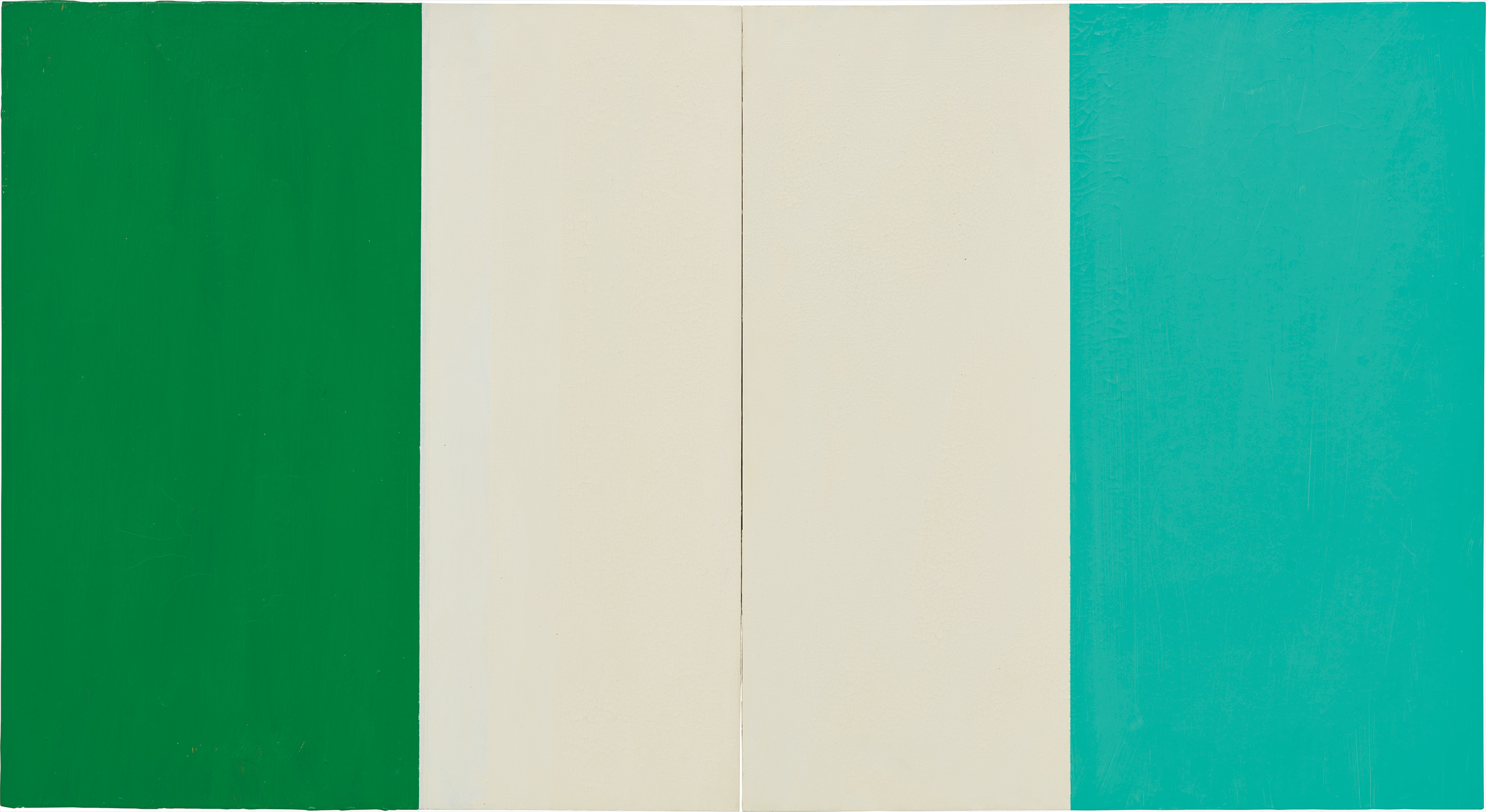

9
Palermo
Wooster Street
overall 57.2 x 104.8 cm (22 1/2 x 41 1/4 in.)
Full-Cataloguing
Throughout his significant yet brief career, Palermo’s artistic output took varied forms and broached myriad categories, from prints, works on paper, wall-drawings, Stoffbilder and objects to Metallbilder. These multi-panelled metal works, executed in acrylic on thin sheets of steel or aluminium, explore Palermo’s preoccupation with the tension between colour and materiality, deconstructing the formal and symbolic potential of composition and tonality. Painted in 1975, the present work directly precedes the artist’s most ambitious work and coda, To the People of New York City (Dia Art Foundation, Beacon). This fifteen-part sequence of forty aluminium panels, considered his magnum opus by art historian Robert Storr, shares formal and material qualities with the present work, a minimalistic homage to New York composed of carefully arranged tonal fields on a multipartite metal support.
Arriving in New York in 1973, Palermo stayed at 141 Wooster Street. 141, was the site of Friedrich’s New York gallery where, in 1974, he co-founded the Dia Art Foundation. It was here that Palermo composed his first works on metal, marking a distinct change in his opus after moving from Germany to New York. Resigning from leaving his works untitled, Palermo began referring to New York in a few works from 1975, psychologically linking them to specific geographical locations in the city. With no representational source, the artist circumscribed association through the title Wooster Street, explicitly clarifying the relationship the composition has to its surroundings. Expanding on the work’s relationship with its eponymous location Helen Winkler Fosdick, co-founder of the Dia, and former owner of the present work, recalls that across the street ‘was a one-story building with a high front…painted the same dark green as Blinky’s Wooster Street. Across the upper front wall was painted ��‘Jarr Fuel’ in white. The Jarr Fuel trucks, painted the same dark green, parked in the building. The front of the building consisted of large garage doors…Blinky and I spent a lot of time sitting on those window sills looking out’ (Helen Winkler Fosdick, quoted in Pia Gottschaller, Palermo: Inside His Images, Munich, 2004, p. 139). Whilst not site specific like his wall drawings both, the title Wooster Street, and the artist’s use of colour afford the present work a unique contingency on location.
Questioning the very identity of painting, the present composition explores the aesthetic and semiotic possibilities of visual representation and is exemplary of Palermo’s expert handling of form and colour. The polychromatic work, composed of three seemingly simple bands of colour, turquoise, green and white is afforded a unique depth, through the unseen layers of orange, yellow and pale blue acrylic paint that lie beneath the composition. Fascinated by the incomparable effects that could be achieved by layering subtly chosen films of paint, ‘Palermo’s unique gift in handling colour from finely graded nuances to the boldest contrasts, provided him with the ability to transform simple metal panels into intricate, subtly tuned symphonies. Just how carefully and painstakingly a process it was for him to get to the core of his endeavour, visualised the innumerable paint layers on the panels themselves’ (Pia Gottschaller, Palermo: Inside His Images, Munich, 2004, p. 164). The present composition radiates with colouristic harmony and Palermo’s experimental facture.
Emphasising the artist’s expert organisation of space, Wooster Street, carefully orchestrated in colour and form, responds to its environment with an unstructured synchronisation. Influenced by the institutional critique of his peers, conceptually manipulating architectural sites, Palermo’s work moves away from the Capitalist Realist tendencies of his German colleagues, Sigmar Polke and Gerhard Richter and echoes the likes of Sol LeWitt, Michael Asher, Daniel Buren and Marcel Broodthaers in the later 1960s. Driven by a belief in evolution and progression, the artist’s minimalist output pays homage to the soft geometric forms of early modernist masters whilst sharing an awareness of the abstractions of Ellsworth Kelly, Agnes Martin, Robert Ryman and Brice Marden.
Deconstructing painting’s traditional materials, conventional format, structure and identity, Palermo’s experimental and prolific artistic legacy is exemplified by his critical approach to creation. Through his minimalist facture, Palermo expertly structures his surroundings and forges space. Bestowed with remarkable historical prominence, through title, rarity and geographic particularity, the present work is an exceptional diptych from the final years of Palermo’s poetic oeuvre.
Palermo
German | B. 1943 D. 1977Blinky Palermo is best known for his monochromatic canvases and fabric paintings made from simple lengths of material cut, stitched and stretched over a frame. Palermo painted on aluminium, steel, wood, paper and Formica, often making lines out of tape instead of paint. He completed approximately 65 paintings between 1966 and 1972 titled Stoffbilder (Fabric Paintings); in this signature series, he took ready-made department-store fabrics and stitched them into vibrant panels.
Palermo studied under Joseph Beuys alongside Sigmar Polke and Gerhard Richter. Public collections holding major works by Palermo include the Museum of Modern Art in New York, the Tate Gallery in London, the Hirshhorn Museum and Sculpture Garden in Washington D.C. and the Dia Art Foundation. Most of the artist's work, however, remains in the possession of private collectors and museums in Europe.